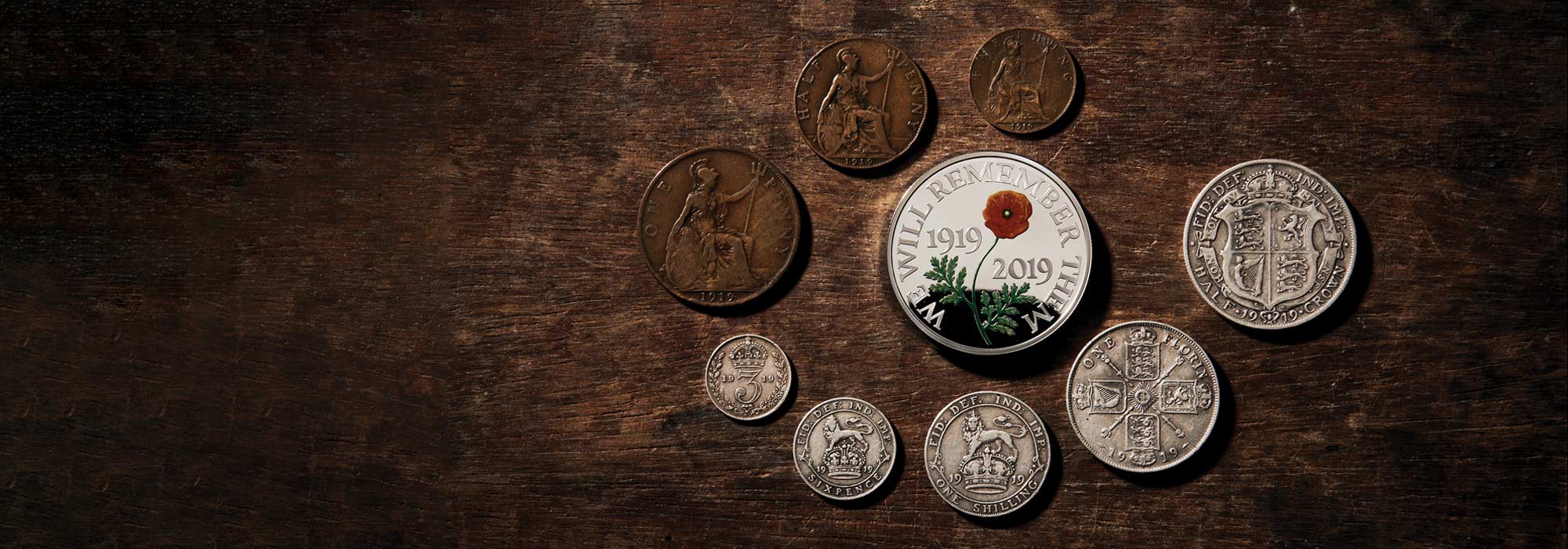
In response to this year's marking of the 100th anniversary of the first remembrance ceremonies, The Royal Mint has procured a number of historic coins from 1919 – the year of the first ’Armistice Day’ ceremony.
The First World War effectively came to an end on 11 November 1918, with the signing of the ceasefire known as the Armistice, and one can imagine the collective sigh of relief in that moment. Brutal and exhausting, the war had claimed some 16 million military and civilian lives, and was fought on multiple continents. For many of those who had survived the war, the psychological trauma of the experience would stay with them the rest of their lives.
In the United Kingdom, there was a growing desire to mark the war's significance, to acknowledge the world-changing effect it had. Initial celebrations of peace were triumphant in feel. But, as the first anniversary of the Armistice drew closer, the desire for a more sombre ceremony gained momentum with the public.
On 7 November, George V issued a proclamation calling for all Britons to observe a two minute silence at exactly the same time as the ceasefire had come into force a year before: ‘on the eleventh hour of the eleventh day of the eleventh month’.
George V's proclamation declared that ‘All locomotion should cease, so that, in perfect stillness, the thoughts of everyone may be concentrated on reverent remembrance of the glorious dead’.
It is Bertram Mackennal's portrait of George V that is to be found on the obverse of the historic coins featured in The 100th Anniversary of Remembrance Day Historic Coin Set, with the reverses carrying designs by Leonard Charles Wyon, George William de Saulles and Jean Baptiste Merlen.
The war had dramatic effect on coinage in the United Kingdom, generally being credited with bringing about the end of gold coins as part of circulating currency. Almost as soon as the war started, the government had issued ten-shilling and one-pound notes and encouraged the public to give up their gold in aid of the war effort. Sovereigns soon began to disappear from circulation and in 1917 their production ceased completely in London.
This had a knock-on effect and created an increased demand for silver and bronze coins that was so great that The Royal Mint had to bring in external help. Contracts were issued to two private mints in Birmingham to produce bronze pennies. Part of the challenge for The Royal Mint during the war years came from the fact it was also tasked with precision munitions work. Things didn't let up after the war ended as The Royal Mint assisted in producing thousands of War and Victory medals; the task was so great that some work had to be subcontracted. It was a workload that meant Royal Mint staff missed out on bank holidays and annual leave.
Still, those workers missing out on days off may have considered themselves lucky. Some 138 staff either enlisted or were conscripted to serve in the war, with a number of them dying in the conflict. In June 1917, the war brought tragedy directly to The Royal Mint when an air raid bombing of The Royal Mint's factories resulted in the deaths of four workers.
As an institution with more than 1,100 years of history, much of it intimately linked with the highs and lows of Britain’s broader history, remembrance is deeply important to everyone at The Royal Mint. A memorial to Royal Mint employees killed in the First World War can be found at the heart of The Royal Mint’s 38-acre site in Llantrisant, Wales, and each year is the loss of life is observed with a two minute silence and wreath-laying ceremony at the memorial.
Additionally, The Royal Mint issues a new Remembrance coin each year, providing a permanent way for everyone to mark the occasion.


